The government’s Inheritance Tax (IHT) take reached a record-high last year. As reported in IFA Magazine, receipts totalled £7.1 billion between April 2022 and March 2023, a £1 billion year-on-year increase.
IHT is charged on the value of your estate that exceeds the tax-free thresholds. These are the:
- Nil-rate band – standing at £325,000 in the 2023/24 tax year
- Residence nil-rate band – standing at £175,000 in 2023/24 if you pass your main residence to your direct descendants. If the total value of your estate exceeds £2 million, your residence nil-rate band may be reduced by £1 for every £2 you are over this limit.
That means you can potentially pass on up to £500,000, or £1 million combined with your spouse or civil partner, without your beneficiaries facing a tax bill.
However, any value over this amount could be subject to the 40% charge. As a result, you may be wondering whether there’s anything you can do to mitigate a tax bill that your loved ones may have to pay when you pass away.
The answer is a resounding yes, as there are methods you can use that might help to reduce what your beneficiaries may have to pay in tax.
However, with that said, it can often be worth taking advice when doing so, as making errors could land your beneficiaries with a larger tax bill than they’re already facing.
So, find out why trying to do your own IHT planning could be costly, and how taking professional advice can help.
Falling foul of IHT rules can land your beneficiaries with a sizable tax bill
As there are various rules and regulations surrounding IHT, that means there are also various pitfalls to be aware of when trying to reduce the bill your family could be facing.
For example, you may have heard of the “seven-year rule” for gifting money or assets. Gifts to other individuals (or to absolute trusts) are known as potentially exempt transfers (PETs). Many people make gifts in their lifetime in the hope that they will live a further seven years, after which the amount will not count towards their estate.
If you die within seven years of making the PET, you may face a tapered rate of IHT, depending on how much time has passed between the gift and your death. The table below shows the tapered rates of IHT:

With this taper relief in mind, many people make PETs anyway, assuming that their beneficiaries might face a lower rate of tax, or even none at all.
However, it’s a little more complicated than that, because PETs will be the first part of your estate assessed against the nil-rate band.
So, your beneficiaries may still not benefit from the reduced rate of tax within the seven years if you have any remaining nil-rate band and the amount gifted doesn’t exceed it.
Other examples of mistakes you might make could be in moving your home into your child’s name while continuing to live there. This may not actually see your property fall outside your estate, as it may count as a “gift with reservation of benefit”.
As a result, your home would still be included in the value of your estate for tax purposes. Additionally, even if you paid your child a market rent to avoid the reservation of benefit, it would still count as a PET under the seven-year rule.
Errors like these could land your loved ones with an unexpected tax bill on your death that you haven’t planned for.
3 practical ways you might be able to mitigate a potential IHT bill
While there can be difficulties in planning around IHT, there are still methods you could use to help you limit the tax bill your beneficiaries may face.
These three practical tips could help you to successfully navigate the rules and mitigate a potential IHT bill on your wealth.
1. Using your gifting allowances and exemptions
While making PETs may land your beneficiaries with an unexpected tax bill, gifting money and assets can still be an effective way of reducing an IHT bill.
That’s because you have a range of gifting allowances and exemptions you can use to tax-efficiently reduce the size of your estate. These include:
- Annual gifting exemption – You can make gifts of up to £3,000 each tax year (or £6,000 as a couple) with this amount falling outside your estate.
- Wedding allowance – You can make tax-free gifts to people who are getting married. This is up to £5,000 for children, £2,500 for grandchildren, and £1,000 for anyone else.
- Small gifts – You can make unlimited gifts of up to £250 to as many people as you like, provided that they don’t receive anything more than this.
By making gifts under these exemptions and allowances, you may be able to put your money into your loved one’s hands without them having to pay tax on it. It could also reduce the size of your estate, meaning the beneficiaries of your will could face a smaller IHT bill on your death.
Furthermore, you could still make PETs, provided that you take great care and prepare your family for the bill they may still face on your death. If you want to make PETs, it could be sensible to take advice first.
2. Drawing income tax-efficiently in retirement
As your pension will typically be excluded from the value of your estate, you may be able to mitigate an IHT bill by tax-efficiently drawing income in retirement from other savings and investments that will most likely be included in the calculation.
So, if you were to live on these savings and investments first before you access your pension, you may be able to spend a portion of your taxable estate. You could start to draw from your pension if you entirely depleted these savings and investments, too.
Then, on your death, your beneficiaries would typically be able to inherit your pension without facing an IHT bill.
If you do intend to do this, there are a few aspects to consider:
- You may want to think about whether this would mean compromising on your retirement lifestyle, and whether that’s something you’re comfortable with.
- You’ll need to complete an “expression of wishes” form with your pension provider, naming your chosen beneficiaries. Bear in mind that this may not guarantee that they’ll receive your pension; it simply means that the provider will take the form into consideration when deciding how to administer your funds on your death.
- Your beneficiaries may have to pay Income Tax on the pension in certain circumstances.
As with other methods of mitigating IHT, there may be pitfalls to navigate when drawing income tax-efficiently. It may be worth taking advice to ensure that it’s an appropriate choice in your circumstances.
3. Work with a professional
Perhaps your most effective option is to work with an expert. A financial adviser can guide you through the various pitfalls of DIY IHT planning, and help you to mitigate the bill your beneficiaries might currently be facing.
If you’d like to find out the most suitable ways for you to mitigate an IHT bill on your wealth, please do get in touch with us at Rosebridge.
Email enquiries@rosebridgeltd.com or call 01204 300010 to find out more.
Please note
This blog is for general information only and does not constitute advice. The information is aimed at retail clients only.
The Financial Conduct Authority does not regulate estate planning, tax planning or will writing.
For taper relief/PETs
Remember that taper relief only applies to gifts in excess of the nil-rate band. It follows that, if no tax is payable on the transfer because it does not exceed the nil-rate band (after cumulation), there can be no relief.
Taper relief does not reduce the value transferred; it reduces the tax payable as a consequence of that transfer.

 Rosebridge® is a trading style of IFA (North) LLP, Pro Sport® Wealth Management Ltd, Stonebridge Wealth Management Ltd and Independent Financial Advisor Ltd. IFA (North) LLP, Pro Sport® Wealth Management Ltd and Stonebridge Wealth Management Ltd are all appointed representatives of Independent Financial Advisor Ltd which is authorised and regulated by the Financial Conduct Authority. Registered in England and Wales No 05246224. Registered address: The Grants, 11 Market Place, Ramsbottom, Bury, BL0 9AJ.
Rosebridge® is a trading style of IFA (North) LLP, Pro Sport® Wealth Management Ltd, Stonebridge Wealth Management Ltd and Independent Financial Advisor Ltd. IFA (North) LLP, Pro Sport® Wealth Management Ltd and Stonebridge Wealth Management Ltd are all appointed representatives of Independent Financial Advisor Ltd which is authorised and regulated by the Financial Conduct Authority. Registered in England and Wales No 05246224. Registered address: The Grants, 11 Market Place, Ramsbottom, Bury, BL0 9AJ. Production
Production